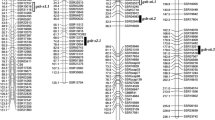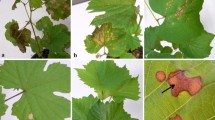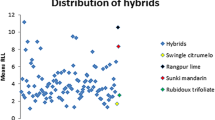Abstract
Citrus gummosis, caused byPhytophthora spp., is an important citrus disease in Brazil. Almost all citrus rootstock varieties are susceptible to it to some degree, whereas resistance is present inPoncirus trifoliata, a closely related species. The objective of this study was to detect QTLs linked to citrusPhytophthora gummosis resistance. Eighty individuals of the F1 progeny, obtained by controlled crosses between Sunki mandarinCitrus sunki (susceptible) andPoncirus trifoliata cv. Rubidoux (resistant), were evaluated. Resistance toPhytophthora parasitica was evaluated by inoculating stems of young plants with a disc of fungal mycelia and measuring lesion lengths a month later. Two QTLs linked to gummosis resistance were detected in linkage groups 1 and 5 of theP. trifoliata map, and one QTL in linkage group 2 of theC. sunki map. The phenotypic variation explained by individual QTLs was 14% forC. sunki and ranged from 16 to 24% forP. trifoliata. The low character heritability (h 2 = 18.7%) and the detection of more than one QTL associated with citrusPhytophthora gummosis resistance showed that inheritance of the resistance is quantitative.
Similar content being viewed by others
References
Averna-Saccá R, 1917. Moléstias da laranjeira. Bol Agr 18: 334–346.
Basten CJ, Wier BS, Zeng ZB, 2001. QTL cartographer, Version 1.15. Department of Statistics, North Caroline State University, Raleigh, N.C.
Beretta MJG, Rossetti V, Teixeira ARR, Sempionato O, 1989. Aplicaçâo dos testes diagnósticos para declínio em plantas cítricas submetidas á transmissâo por enxertia de aproximação de raízes. Laranja 2: 347–359.
Churchill GA, Doerge RW, 1994. Empirical threshold values for quantitative trait mapping. Genetics 138: 963–971.
Cristofani M, Machado MA, Grattapaglia D, 1999. Genetic linkage maps ofCitrus sunki Hort. ex. Tan. andPoncirus trifoliata (L.) Raf. and mapping of citrus tristeza virus resistance gene. Euphytica 109: 25–32.
Deng Z, Huang SY, Xiao S, Gmitter F, 1997. Development and characterization of SCAR markers linked to the citrus tristeza virus resistance gene fromPoncirus trifoliata. Genome 40: 697–704.
Falconer DS, 1989. Introduction to quantitative genetics. Longman Scientific and Technical, Stanford.
Fawcett HS, 1923. Gummosis on citrus. J Agric Res 24: 235–255.
Feichtenberger E, 2001. Doenças incitadas porPhytophthora em citros. In: Luz ENM, ed. Doenças causadas porPhytophthora no Brasil, Livraria Rural Editora, Campinas: 283–342.
Gimenes-Fernandes N, Bassanezi RB, 2001. Doenças de causa desconhecida afeta pomares cítricos no norte de São Paulo e sul do Triângulo mineiro. Summa Phytopathologica 27: 93.
Gmitter Jr FG, Xiao SY, Huang S, Hu XL, Garnsey SM, Deng Z, 1996. A localized linkage map of the tristeza virus resistance gene region. Theor Appl Genet 92: 688–695.
Grattapaglia D, Bertolucci FL, Sederoff RR, 1995. Genetic mapping of QTLs controlling vegetative propagation inEucalyptus grandis andE. urophylla using a pseudo-testcross strategy and RAPD markers. Theor Appl Genet 90: 933–947.
Guerra MS, 1993. Cytogenetics of Rutaceae. V. High chromosomal variability inCitrus species revealed by CMA/DAPI staining. Heredity 71: 234–241.
Hutchison DJ, 1985. Rootstocks development screening and selection for disease tolerance and horticultural characteristics. Fruit Var J 39: 21–25.
Lander ES, Botstein D, 1989. Mapping Mendelian factors underlying quantitative traits using RFLP linkage maps. Genetics 121: 185–199.
Ling P, Duncan LW, Deng ZB, Dunn D, Hu X, Huang S, Gmitter Jr F, 2000. Inheritance of citrus nematode resistance and its linkage with molecular markers. Theor Appl Genet 100: 1010–1017.
Matheron ME, Matejka JC, 1992. Effects of temperature on sporulation and growth ofPhytophthora citrophthora andPhytophthora parasitica and development of foot and root rot on citrus. Plant Dis 76: 1103–1109.
Mestre PF, Asins MJ, Pina JA, Carbonell EA, Navarro L, 1997. Molecular markers flanking citrus tristeza virus resistance gene fromPoncirus trifoliata (L.) Raf. Theor Appl Genet 94: 458–464.
Moreira S, 1942. Observaçôes sobre a “tristeza” dos citrus ou “podridão das radicelas”. O Biológico, São Paulo 8: 269–272.
Müller GW, Negri JD, Aguilar-Vildoso CI, Mattos Jr. D, Pompeu Jr. J, Teófilo Sobrinho J, et al. 2001. Quick Blight of sweet orange: a new citrus disease in Brazil. Programme & Abstracts of XV Conference of the International Organization of Citrus Virologists : 100.
Pompeu Jr. J, 1991. Porta-enxertos. In: Rodriguez O, Viegas F, Pompeu Jr., Amaro AS, eds. Citricultura Brasileira. Campinas, SP, Fundaçâo Cargill: 116–152.
Rossetti V, 1947. Estudos sobre a gomose dePhytophthora dos citros I. Suscetibilidade de diversas espécies cítricas a algumas espécies dePhytophthora. Arq Inst Biol 18: 97–124.
Timmer LW, Garnsey SM, Graham JM, 2000. Compendium of citrus diseases. APS Press, St. Paul.
Yoshimaru H, Ohba K, Tsurumi K, Tomaru N, Murai M, Mukai Y, et al. 1998. Detection of quantitative trait loci for juvenile growth, flower bearing and rooting ability based on a linkage map of sugi (Cryptomeria japonica D. Don). Theor Appl Genet 97: 45–50.
Zeng ZB, 1993. Theoretical basis of separation of multiple linked gene effects on mapping quantitative trait loci. Proc Natl Acad Sci USA 90: 10972–10976.
Zeng ZB, 1994. Precision mapping of quantitative trait loci. Genetic 136: 1457–1468.
Author information
Authors and Affiliations
Corresponding author
Rights and permissions
About this article
Cite this article
Siviero, A., Cristofani, M., Furtado, E.L. et al. Identification of QTLs associated with citrus resistance toPhytophthora gummosis. J Appl Genet 47, 23–28 (2006). https://doi.org/10.1007/BF03194595
Received:
Accepted:
Issue Date:
DOI: https://doi.org/10.1007/BF03194595




